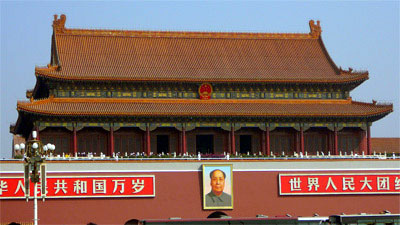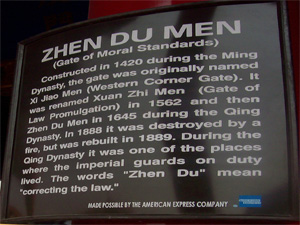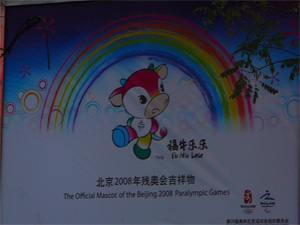TABLE
OF CONTENTS
|
"Brought to You By American
Express"
By: Danica
Taylor

In China there
were endless representations of vernacular and transnational
architecture. An
example of this struck me while touring around the Forbidden City in Beijing. The
Forbidden
City was created before America
was even discovered by Christopher Columbus, and was closed to the
public for
over 500 years. The museum displayed ways that the ancient Chinese
constructed
the buildings and the displayed unthinkable tools they had for hunting,
building, and maintaining the palace for the royalty.
Each display had a nice sign in front of it
describing the tool, or identifying which building it was and what its
purpose
was. But when you got to the bottom of the showcase caption, there it
was, the
transnational component of the ancient vernacular architecture “Made
Possible by the American Express Company.” 
If it weren’t for some American corporate sponsor
there
may not have been captions in English for the English speaking
visitors, or who
knows maybe the Chinese government would not have provided any funding
for any
captions. Although grateful for the captions, it was also a big slap in
my face
that reminded me that I was at one of the main tourist attractions in
all of China.
Another
interesting connection between the vernacular architecture of the
Forbidden City and Beijing’s globalized
surroundings was
the immense amount of construction and renovation all in result of the
2008
Summer Olympics in Beijing.
My first impression after walking outside the airport was the smell,
the
pollution, and the advertising of the Olympics everywhere you looked.
The
taxi
ride from the airport to the hotel was surprising, so much
construction, so
much pollution, and so much dust everywhere you looked. In the article
“Beijing’s
Urban Makeover: the ‘hutong’ destruction” author Sean Gallagher goes
far enough
to describe it as “on every street corner in Beijing there is some form
of
demolition or construction taking place.” (Gallagher, 1). It wasn’t
until the
Forbidden City though that I became aware of the impact of
“China’s
Second Industrial
Revolution” (Gallagher, 1). As we were leaving this ancient masterpiece
of art
and architecture we were surrounded and mobbed by men trying to
persuade us to
come to the area of the hutong with them. They had pamphlets and maps
showing
you how close the areas was from where we were now. If it were not for
the
Gallagher reading and discussion in class I wouldn’t have even known
what the
hutong was and probably would have completely disregarded the entire
event. But
instead, I educated those who I was traveling with and informed them
the hutong
were “alleyways…[and are] revered as a direct link to China’s
much venerated past”
(Gallaher, 1), a type of architecture that ties the previous China with
the new
industrialized one. The hutong are being completely evacuated all for
one
global, profitable event. History is being destroyed simply because the
Communist government owns all of the property in China, “subsequently
allowing
for the continued abuse by contractors to demolish and clear hutongs
virtually
unopposed” (Gallagher, 1). 
Transnational corporations are profiting
prolifically from their desire to build and renovate Beijing’s
downtown area, to impress and accommodate all the tourists, companies,
athletes, and media who will be arriving in Beijing in 2008.
It
was a strange connection walking out of the Forbidden City, a
vernacular
masterpiece that was closed to the public for over 500 years, and
walking into
a global city being completely renovated and watching history be
destructed
before your eyes, all for desire to become global and to be seen from
around
the world as a desirable and glorified city to visit. I think that the
Gallagher article encouraged readers to take a closer look at the
situation and
to realize the severity of this problem. It’s not just that they’re
tearing
town history, they’re tearing down people’s homes and leaving them with
no
where else to go besides the streets. There is a serious moral issue
which lies
underneath all the profit and media attention Beijing will be receiving in the
upcoming
years.
|



